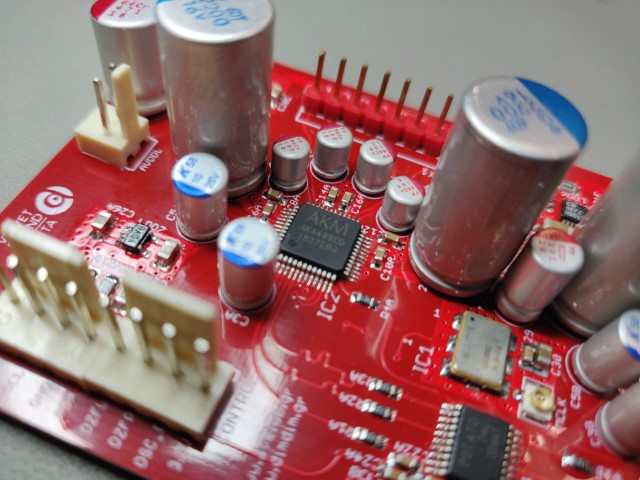 Time flies when you’re having fun. Or are just too busy with things, in general.
Time flies when you’re having fun. Or are just too busy with things, in general.
It’s been two and a half years since I posted about my Dual Mono AK4490 DAC. That DAC has been built and is in use by at least 6 people, other than myself. All of them have been very satisfied with its performance.
But since then quite some water has passed under the bridge.
Among other things, the AK4493 chip came out, and it was just that much different than the AK4490 that I had to update my design to accommodate it.
Feature-wise it was pretty enticing. It looked more like a limited performance version of the AK4497 than an upgraded version of the AK4490. So I had to try it out.
Since I was going to update the PCB design, I thought I might as well improve on as much as I could. So, the new board would:
- Include a new reclocking solution. I went for the best specc’ed chip out there, the famous Potato Semi PO74G374A. One chip would take care of the all of the I2S lines for both DAC chips.
- Add a couple of external 1.8V DVDD power supplies.
- Make some optimization of the LT3042 local regulators’ layout, in order to accommodate larger package capacitors (1206) where it would make most sense.
- Give access to the zero-detect lines of one of the dac chips. These pins could be used to easily implement auto muting of the output stage.
- Give access to the Enable pin of the Si570/Si544. The use of this Enable pin will be explained later.
In addition I would use the then new Si544 programmable oscillator, offering improved performance over the Si570. This did not require any changes to the pcb.
This is the updated schematic:
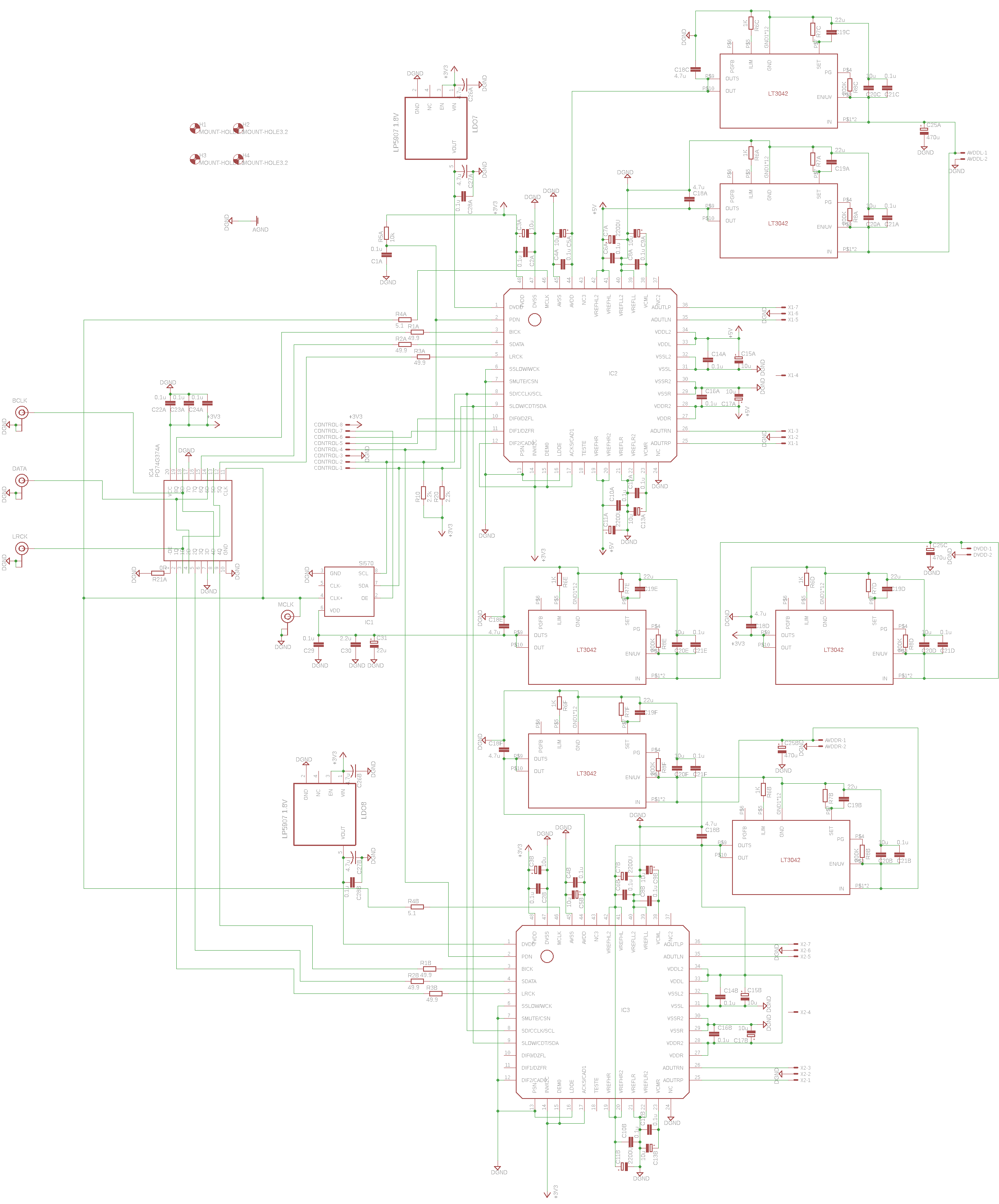 (Right click, Save Image As.. to download it in full resolution)
(Right click, Save Image As.. to download it in full resolution)
This is the 4-layer PCB:
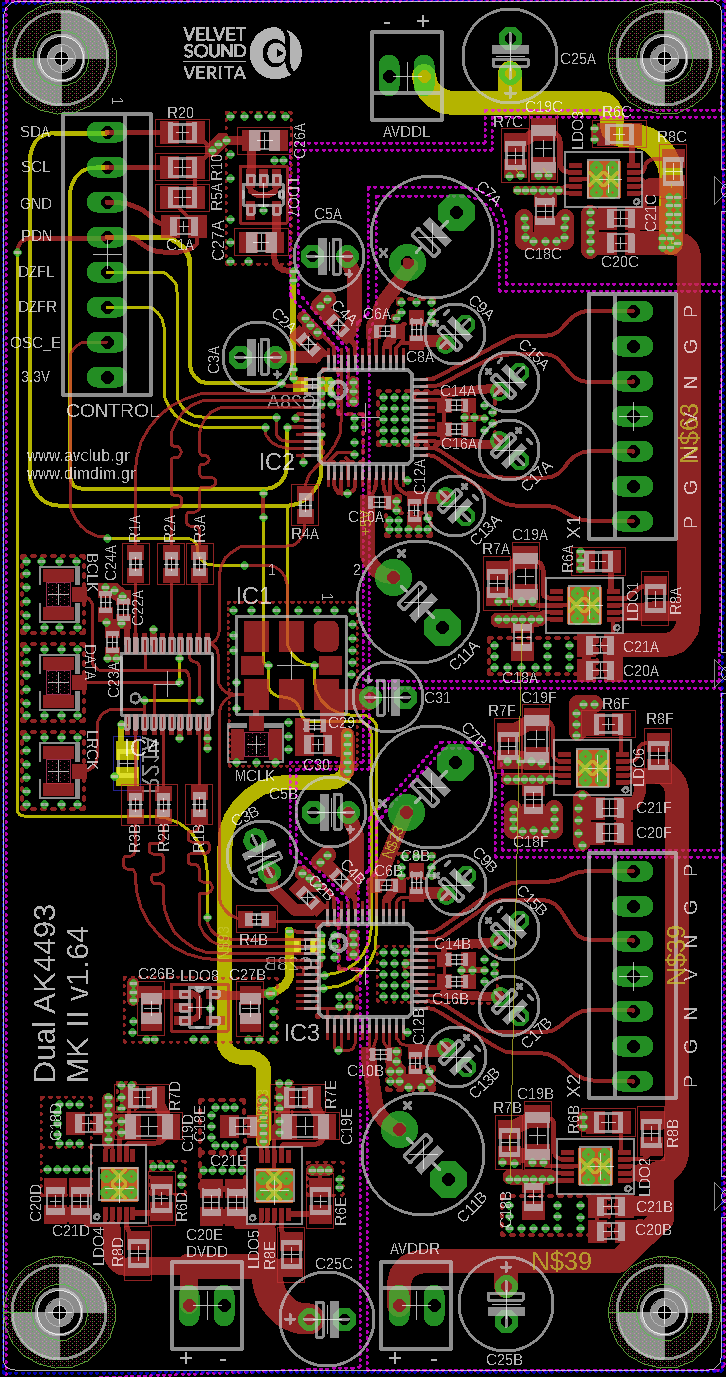 And this is the BoM (v1.9) in xls format:
Dual AK4493 DAC (main board BoM) (27584 downloads )
And this is the BoM (v1.9) in xls format:
Dual AK4493 DAC (main board BoM) (27584 downloads )
The finished board looked like this:
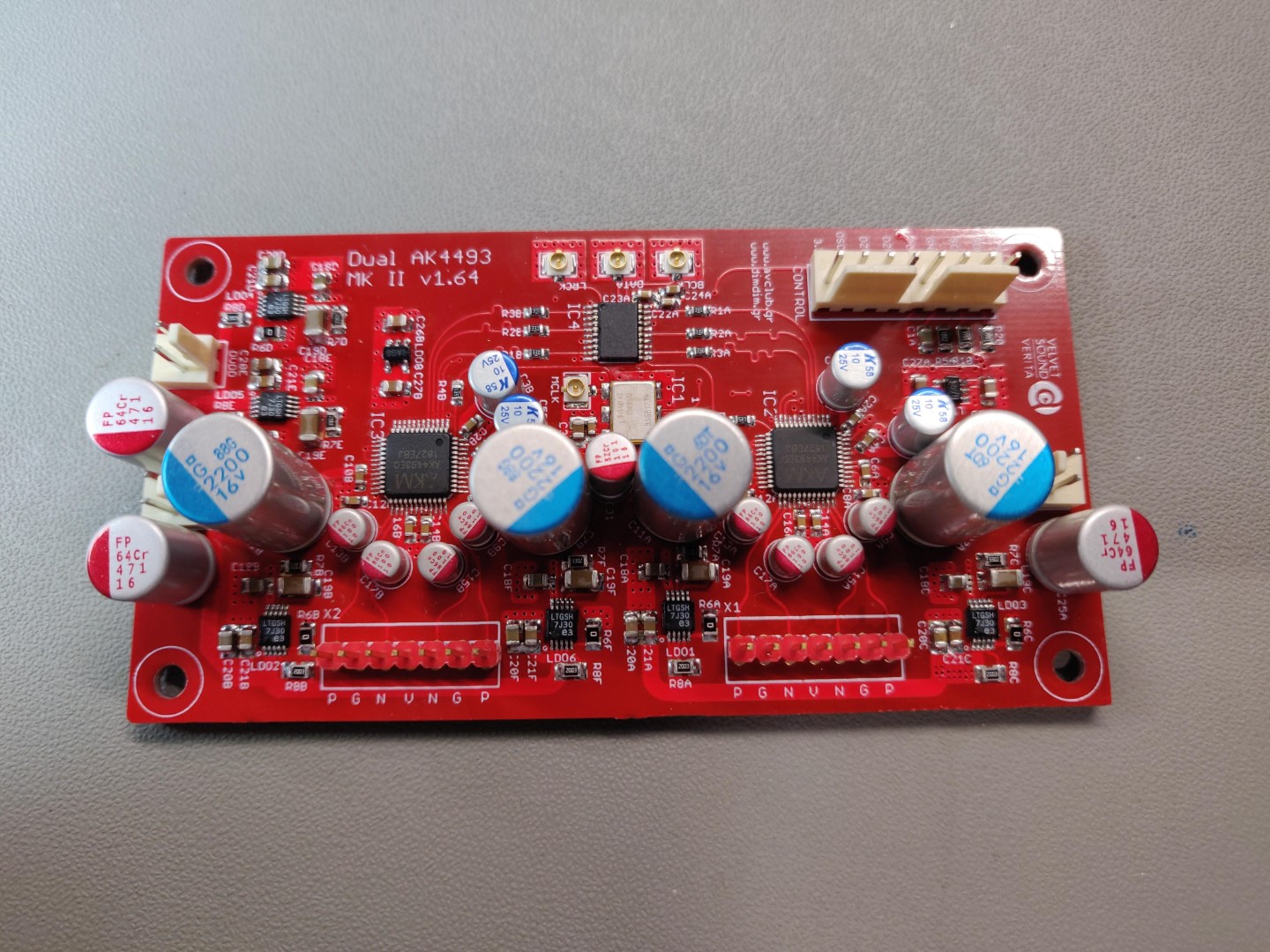 The design consideration, powering scheme and clocking considerations remain the same as with the original design. There is not much sense in repeating the same text here. I will make a few notes though, based on the experience gathered from building, testing and listening to several such DACs.
The design consideration, powering scheme and clocking considerations remain the same as with the original design. There is not much sense in repeating the same text here. I will make a few notes though, based on the experience gathered from building, testing and listening to several such DACs.
- Reclocking is indeed a good idea, offering both measurable improvement in jitter as well as better sound quality.
- The pre-regulators that power this board matter. A lot. Especially the ones for AVDDL & AVDDR. We got the best (audible) results by using a couple of paralleled LT3045s.
- In a resolving system, any change in anything makes audible differences. I was particularly surprised to hear how much of a difference having correct (and uniform across my devices / stereo components) electrical phase in my power cords made.
Also, having a properly designed and implemented USB to I2S receiver is very important. Early on I realized that it would be best if I designed my own XMOS-based receiver board, custom tailored to my needs. It would also include some light USB line conditioning and an AK4118-based S/PDIF receiver with 4+2 inputs. I would then standardize my DAC designs with this inputs board in mind, including properly supporting it in my Arduino code.
And so this board came to be:
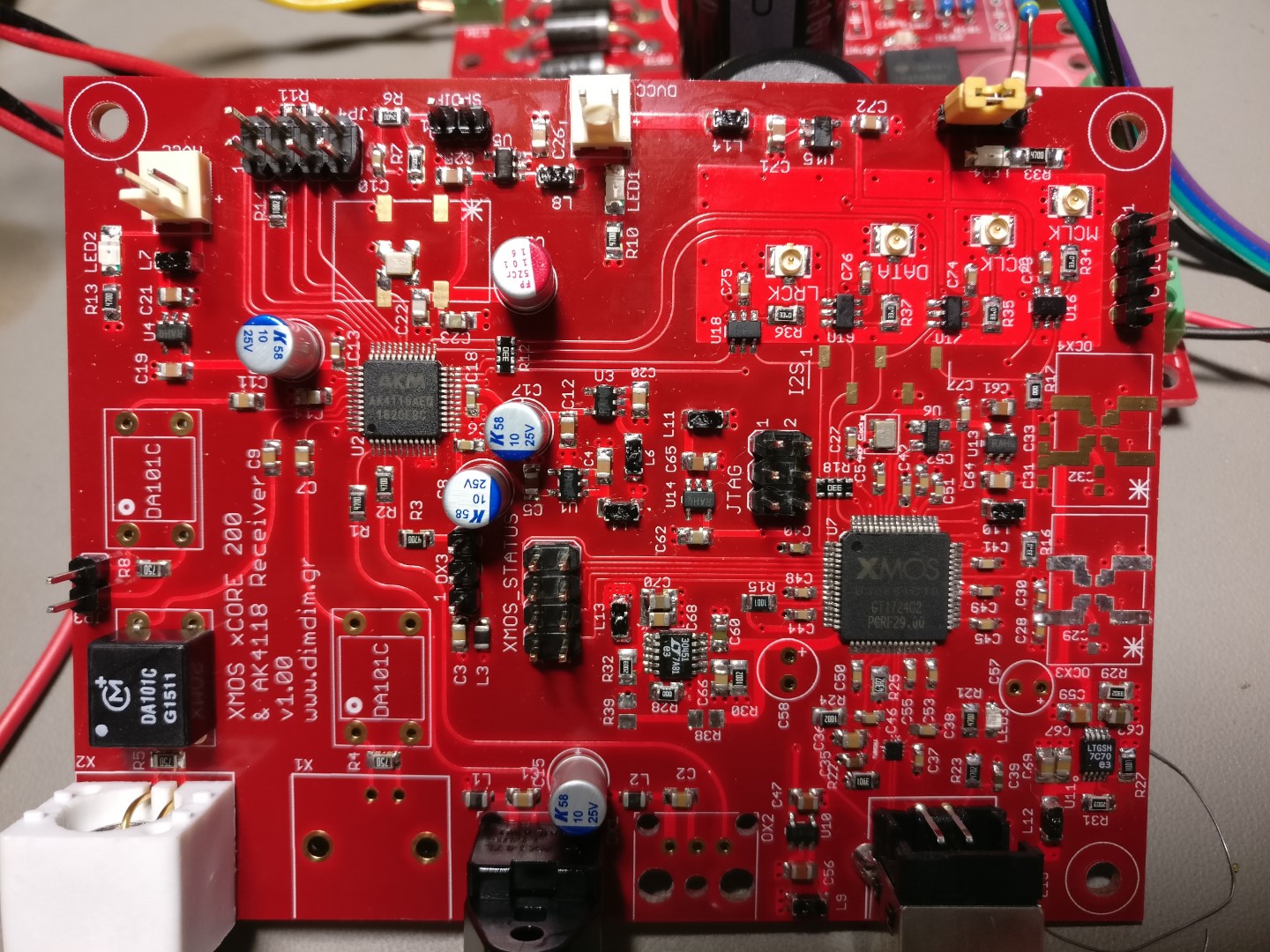 Describing in detail this board is beyond the scope of this post, but suffice it to say, building it is not for beginners. Plus you will need XMOS’ xTAG programmer to burn firmware into the XMOS chip. If anybody is feeling particularly adventurous, drop me a line and I’ll see if I have any PCBs left.
Describing in detail this board is beyond the scope of this post, but suffice it to say, building it is not for beginners. Plus you will need XMOS’ xTAG programmer to burn firmware into the XMOS chip. If anybody is feeling particularly adventurous, drop me a line and I’ll see if I have any PCBs left.
Now, regarding the Arduino code needed to control this board(s), it is not very different than that used to control the AK4490s. The main differences are:
- It has been adapted to enable the AK4493s’ PCM/DSD auto detection feature
- It has support for all of the AK4493’s digital filters
- It has support for triggering a muting relay
- It now supports the Si544 instead of the Si570
- It offers full compatibility with my XMOS / SPDIF board.
There are a number of to-do’s though, such as displaying the bit depth of the incoming PCM signal (from the USB port), plus more information on the incoming DSD stream (such as whether it is in DoP or Native format).
The hardware of the controller is the same that was used with the Dual Mono AK4490 DAC.
In this download I am including the modified versions of the libraries (as mentioned in the above linked post) as well as the necessary font files. Be sure to extract the contents of “Libraries (place in Libraries folder)” to your Arduino IDE’s “libraries” folder.
Download it here: aKduino v3 (123258 downloads )
Regarding the output stage, it is the same design that was used for the AK4490 DAC. However its output level is slightly lower than that of the AK4490 board since the AK4493’s VREF voltage is limited to 5.25V, compared to about 7V of the AK4490. This difference in volume is easy to compensate for by changing a few resistors on the output stage.
Here is a pic of the 3 boards in action: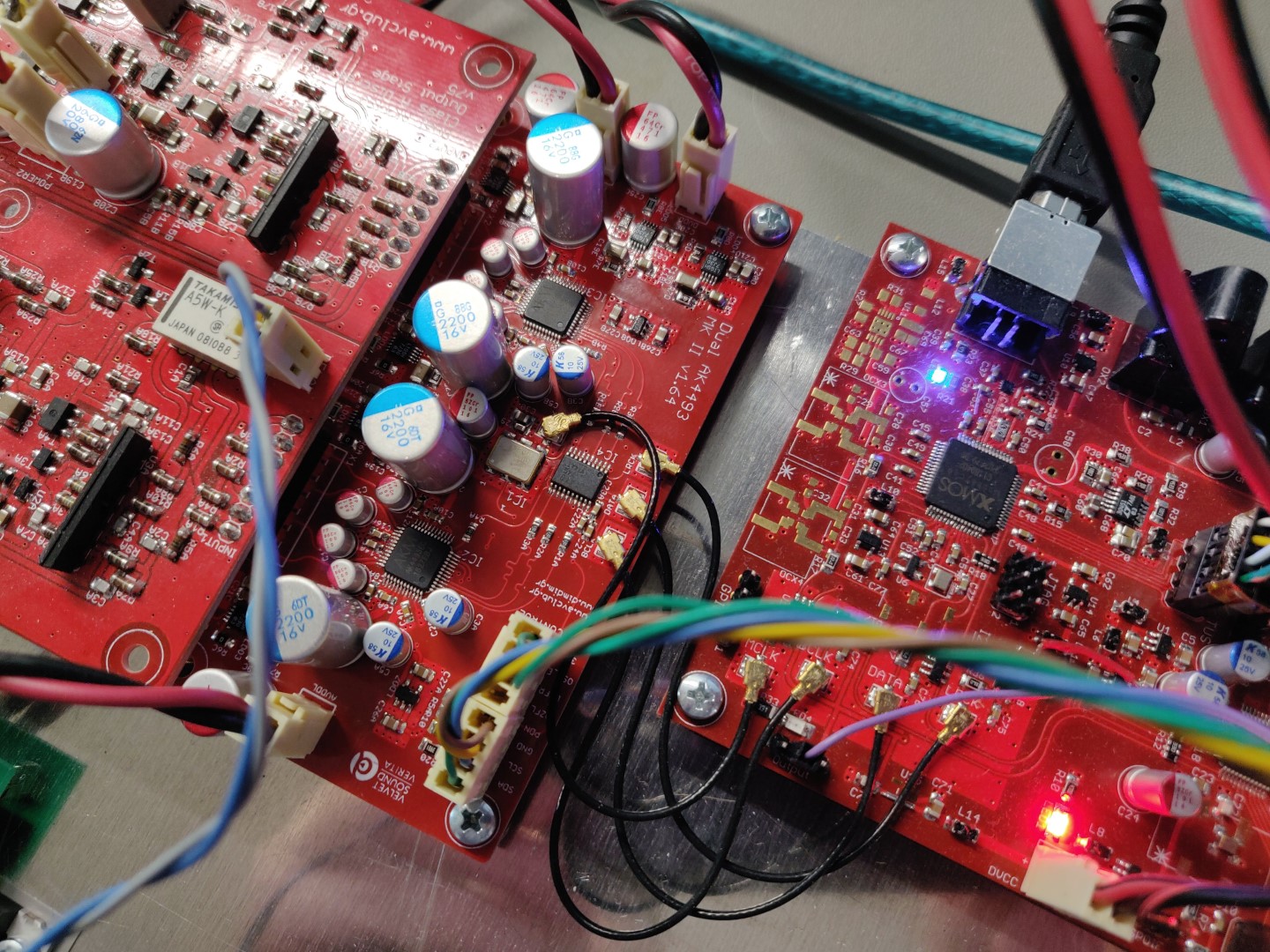 At the time of this writing there have been built 4 DACs based on this updated DAC design PCB.
At the time of this writing there have been built 4 DACs based on this updated DAC design PCB.
If anybody is interested in building this DAC drop me a line. I have a few spare boards lying around.

Pingback: Dual Mono AK4493 DAC (MK II) – gStore
What are these used for? Any pcbs left?
These boards are used to build a Digital to Analog Converter, a device used to convert a digital audio signal to analog form, in order to “feed” an amplifier that will in turn drive speakers.
Hello Dimdim and congrats for the great blog,
I was wondering wether you could give some more detail in how you designed the xmos board.
Thanks
Hi there, thank you for your kind words.
I’ve decided against posting publicly details about my XMOS implementation out of fear that it will be copied and sold on Ebay. But I can give info privately, via email. So contact me.
Thanks so much for your reply,
I’ve sent you an email.
Hello Dimdim, I’m interested in your project, but not enough XMOS knowledge.
I’m also interested in the implementation of XMOS, do not share the infirmation?
Thank.
Pingback: Dual Mono AK4493 DAC (MK II) - 3d Electronic Circuits .com
Hi dimdim, I dropped you an email regarding the DAC PCBs, I would like to build one
Hi Dave, I’m replying right now..
Im so intetested building my first DAC with your help. Greetings from Istanbul.
Hi DimDim
Your DAC is a pure motivation to work on my own design (DSD1792A). It is good to see a reference digital design, for a rookie it means a lot.
Hi Dimdim, this is a very interesting project! I am interested in buying the necessary PCBs, can we get in touch by email?
Hi there, I’m emailing you..
Hi Dimitris,
after reading your articles (also the ones from the AK4490 dac) I’m very excited and would like to build it myself. In the first part of the AK4490 dac series you mentioned an overall project page once all the parts are ready. Did I miss that somehow? I couldn’t find that here or on diyaudio forum. Nevertheless I would try it, but having the gerber files of dac, controller and output stage would be nice. I’m good at soldering but not at PCB design 😛
Great work. Have a nice Sunday.
Tom
Hello Dimitri,
Have you considered using the LT3040 instead, that it’s designed for DAC or using the lt3042 with a voltage reference that seems to lower the noise on the low frequencies ?
Stavros
What chip do you use to switch i2s data ?
I use 7SB3257DTT1G mux/demux ICs.
Hi, i tried reaching to you by email, but it seems there was a problem.
I would like to build this dac (and possibly outptu stage as well) and I would love if you could send me gerber files and pdf schematic so I can just send it to a pcb house.
Regards and thank you for your work.
Hi Dimdim,
I really like your overall design mentality and aesthetic. I am a mere hobbyist but I have seen very few other designs that reflect the same level of care you take. The pandemic has still made getting parts very difficult so it is premature for me to try and buy pcbs or other parts. Do you instead offer the gerbers or Eagle files for this project for sale?
Thanks so much, Kevin
Hi there Kevin,
I do not sell files. I don’t even sell boards. All I do is get rid of surplus PCBs, at cost, left over from my projects.
With that said, I have no problem sharing gerbers via email. I suppose that the Gmail that you used to post this comment is valid, right?
Oh man, thank you very much for responding I expected to receive any responses in my email and I only now though to check back to this blog. My apologies for the delay. That gmail is definitely the one, but that’s incredibly kind of you. Can I at the very least buy you a coffee? Over Venmo or PayPal or something?
Hi Dim, I hope you had a great holiday. I just wanted to check in and ask if you saw my previous post. I certainly don’t wish to be a bother, especially when effectively asking for a handout, but at the same time I was very excited about the prospect of the gerbers (or Eagle files?), as well as the donation of a coffee 😉 Thank you again!
Hi
Your work is of an impressive level!
I am currently using the AK4495 in hardware mode with a spdif receiver and I would like to switch to software mode to benefit in particular from the digital potentiometer. Do you think that your arduino program for the 4493 is usable for the 4495? I don’t have XMOS so I wonder if it can also work with a simple 4118 receiver
I also wanted to develop a dual mono version with the new AK4493S when I discovered your amazing achievement. It really makes me want to reach such a level so my question is, do I need to rebuild a new board? Can I use your stm32 based schematic for this new chip and if so do you still have boards to sell?
Thank you and happy holidays
alban
Hi ! Great design…Actually I use a rasPi + Kali reclocker (because of great jitter of raspberry I2S output) + DAC w/PCM1794, but I want to build something new with a better DAC. Shall I use your DAC as a Master DAC and RasPi as a slave ?
Hi, why is pin 12 of IC2 connected to 3.3V and in IC3 to IDNG
Pins 12 and 17 set the I2C address of the chip. The two chips need to have different I2C addresses in order to be individually controlled by the uC, so different combinations of HIGH/LOW need to be set.